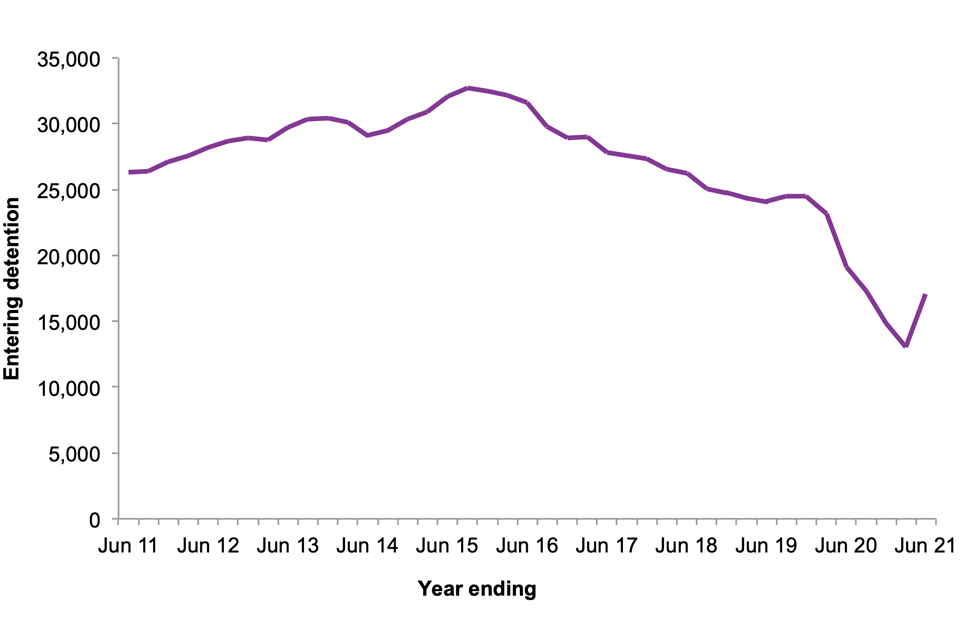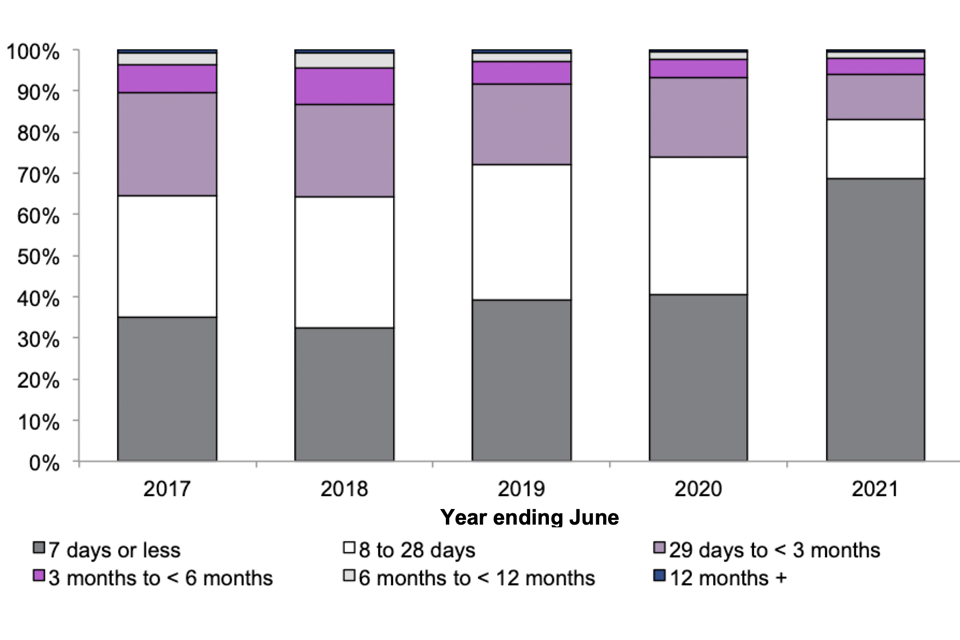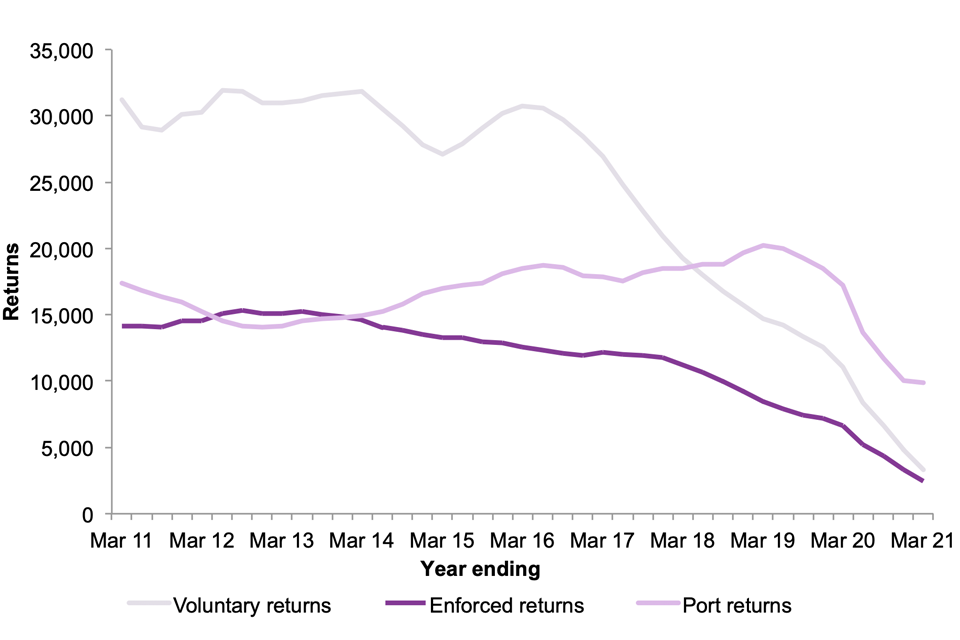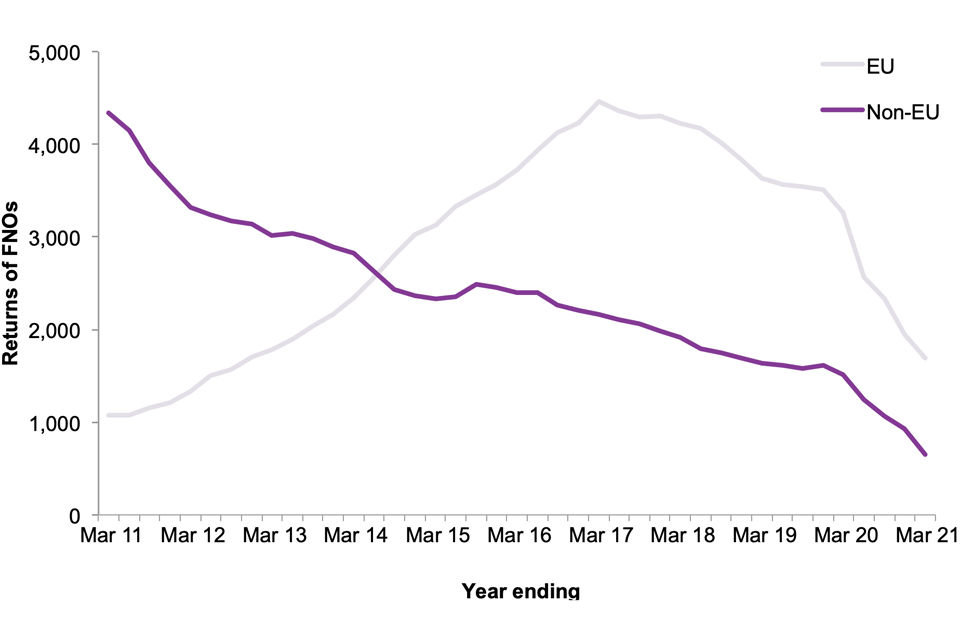How many people are detained or returned?
Updated 26 August 2021
Back to ‘Immigration statistics, year ending June 2021’ content page.
This is not the latest release. View latest release.
Data on immigration detention relates to year ending June 2021 and all comparisons are with year ending June 2020, unless indicated otherwise. Data on returns relate to year ending March 2021 to allow more time for returns to be recorded on the system and ensure the published figures are an accurate representation of the number of returns. See the user guide for more details.
On 11 March 2020, the World Health Organisation (WHO) declared the COVID-19 outbreak as a global pandemic. A range of restrictions were implemented in many parts of the world, and the first UK lockdown measures were announced on 23 March 2020. The COVID-19 pandemic has had a significant impact on the UK immigration system, both in terms of restricting migrant movements to and from the UK and the impact on operational capacity.
Year ending comparisons that follow will include impacts resulting from the restrictions put in place during this period of the pandemic.
This section contains data on:
- Individuals detained under Immigration Act powers
- Returns of people who do not have any legal right to stay in the UK
1. Immigration detention
17,088 people entered Immigration detention in the year ending June 2021, 11% fewer than the previous year.
There has been a general downward trend in numbers entering detention since the peak in 2015, as shown in Figure 1, when over 32,000 people entered detention.
There were large falls in the numbers entering detention immediately following the COVID-19 outbreak in late March 2020. Just 1,834 people entered detention in 2020 Q2 (April to June), but numbers have since increased reaching 5,878 in 2021 Q2. This is comparable with pre-pandemic levels (5,792 in 2019 Q2). Since the pandemic, an increasing proportion of those entering detention have been recent clandestine arrivals detained for short periods for processing. The number detained for other reasons has fallen.
Iranians were the most common nationality entering detention in the latest year, accounting for 14% of the total, or 2,317 entrants, which is a 32% increase on the previous year. Albanians were the next most common nationality entering detention, although their number (2,273) was 19% fewer than in the previous year. While most other nationalities saw falls in numbers entering, there was a near four-fold increase in the number of Sudanese (+952) and Vietnamese nationals (+722) compared with the previous year.
Figure 1: People entering immigration detention in the UK, year ending June 2011 to year ending June 2021

Figure 2 shows the number of people detained in prisons solely under immigration powers increased by 52%, from 368 at the end of June 2020 to 558 at the end of June 2021. This may reflect falls in the number of returns, as well as challenges around releasing some foreign national offenders (FNOs) into the community. The number detained in the detention estate (IRC, STHF & PDA) fell immediately following the pandemic (555 at the end of March 2020), but has increased since, with 992 people detained at the end of June 2021. This remains below pre-pandemic levels (1,278 at the end of December 2019).
Figure 2: People detained under immigration powers in the UK, by place of detention, as at the last day of the quarter, Q1 2018 to Q2 20211,2

Source: Immigration detention – Det_D01
Notes:
- The ‘detention estate’ comprises Immigration Removal Centers (IRC), Short Term Holding Facilities (STHF) and Pre-departure Accommodation (PDA). It excludes those who are detained under Immigration powers in prisons.
- 2019 Q4 is the last data point before the pandemic with 2020 Q1 being immediately following the first UK lockdown.
At the end of June 2021, there were 1,550 people in immigration detention (including those detained solely under immigration powers in prison), more than double the number at the end of June 2020 (698) when the impact of the pandemic on numbers was most pronounced, but 5% fewer than at the end of December 2019 (1,637).
Figure 3 shows that an increasing proportion of people who were detained spent short periods in detention - 69% of those who left detention in year ending June 2021 were detained for seven days or less, up from 40% in the previous year. This is in part due to an increasing proportion of detainees being detained for short periods on arrival to the UK before being bailed, typically while their asylum (or other) application is considered.
Figure 3: People leaving immigration detention, by length of detention1,2, year ending June 2017 to year ending June 2021

Source: Immigration detention – Det_D03
Notes:
- Data from July 2017 includes those leaving detention through HM Prisons. Data are not directly comparable with previous years. See the user guide for more details.
- ‘ < ’ means ‘less than’.
Although there have been longer-term falls in the number of returns in recent years, the pandemic also impacted the number of returns – 3,689 people were returned directly from detention in year ending June 2021, down from 6,484 in year ending June 2020. In contrast, in 2010 there were 16,577 returns. A recent research report ‘Issues raised by people facing return in immigration detention’ (Home Office, 2021) provides information on some of the reasons for this trend.
Since the pandemic, an increasing proportion of detainees have been recent arrivals to the UK being detained for short periods on arrival before being bailed (typically while their asylum claim is considered). This combined with falling returns has led to a fall in the proportion of detainees being returned from detention (23% in the year ending June 2021, down from 32% in the previous year and 64% in 2010).
Figure 4 shows that among the top 10 nationalities leaving detention in year ending June 2021, there were differences in whether people were granted bail or returned from the UK. For example, 99% (1,035) of Eritrean nationals and 98% (2,218) of Iranians were granted bail. However, 88% (787) of Romanians and 69% (326) of Poles who left detention were returned from the UK. Changes in the overall proportion of people who receive bail or who are returned from the UK will therefore, partly reflect changes in the mix of nationalities who are detained.
Figure 4: Top 10 nationalities leaving detention by reason for leaving1,2, in year ending June 2021

Source: Immigration detention – Det_D03
Notes:
- Bailed (SOS & IJ) Secretary of State & Immigration Judge.
- Other reasons for leaving detention include being sectioned under the Mental Health Act, entering criminal detention, being granted leave to enter or remain in the UK, and detained in error. See the user guide for more details.
2. Returns
In the year ending March 2021, enforced returns from the UK decreased to 2,420, less than half the number (64% fewer) in the previous year, and the lowest number since the series began in 2004. Although the number of enforced returns has been declining since the peak in 2012, as Figure 5 shows, the sharp fall in the latest year was related to the impact of the COVID-19 pandemic. There were just 361 enforced returns in 2020 Q2 (April to June), immediately following the outbreak. Although numbers did increase in Q3 (837) and Q4 (800), they decreased to 422 in 2021 Q1, coinciding with the lockdown imposed in early January 2021.
In the year ending March 2021, there were 3,317 voluntary returns, continuing a downward trend since 2016, as Figure 5 shows.
There were 9,877 passengers who were refused entry at port and subsequently departed (‘port returns’) in the year ending March 2021, 43% fewer than the year ending March 2020. The number of port returns in 2020 Q2 fell significantly as very few passengers arrived in the UK immediately following the outbreak of the COVID-19 pandemic. The number of port returns has increased since, as passenger arrivals began to increase, although remain below pre-pandemic levels. There were a similar number of port returns in 2021 Q1 (3,382) to the previous quarter in 2020 Q4, however the picture displayed is mixed. There was a large increase in port returns of EU nationals (and in particular at juxtaposed controls) which increased more than three-fold. Non-EU nationals showed a decrease over the same period.
Figure 5: Returns from the UK, by type of return1, year ending March 2011 to year ending March 2021

Source: Returns – Ret_D01
Notes:
- ‘Voluntary returns’ include ‘other verified returns’ which are subject to upward revision (particularly for the last 12 months) as in some cases it can take time to identify people who have left the UK without informing the Home Office.
The longer-term fall in returns is due to a number of factors. The majority of enforced returns occur from detention. As reported in the publication ‘issues raised by people facing return in immigration detention’, nearly three-quarters of people detained within the UK following immigration offences in 2019, raised one or more ‘issues’ likely to be preventing return (such as an asylum claim, legal challenge, or referral as a potential victim of modern slavery), up from 63% of people raising an issue in 2017. These issues are likely to affect non-EU nationals to a greater extent than EU nationals.
As Figure 6 shows, prior to the pandemic, the number of enforced returns of non-EU nationals had fallen from 13,247 in the year ending March 2013 to 3,396 in the year ending March 2020. Enforced returns of EU nationals also decreased in recent years from 5,004 in the year ending March 2017 to 3,258 in the year ending March 2020. Returns of both EU and non-EU nationals have continued to fall following the COVID-19 pandemic.
Figure 6: Enforced returns from the UK, for EU and non-EU nationals1, year ending March 2011 to year ending March 2021

Source: Returns – Ret_D01
Notes:
- EU nationals may be returned for abusing or not exercising Treaty rights, or for deportation on public policy grounds such as criminality.
The top 5 nationalities accounted for 69% of the total enforced returns in the year ending March 2021 – these were Romania (25%), Albania (17%), Poland (13%), Lithuania (11%) and Bulgaria (3%). All the top 5 and most other nationalities saw large decreases in enforced returns in the year ending March 2021, compared with the year ending March 2020.
Table 1: Top 5 nationalities1 who had enforced returns2 from the UK, year ending March 2020 and year ending March 2021
| Year ending March 2020 | Year ending March 2021 | Change | Percentage Change | |
|---|---|---|---|---|
| Romania | 1,292 | 614 | -678 | -52% |
| Albania | 802 | 404 | -398 | -50% |
| Poland | 598 | 320 | -278 | -46% |
| Lithuania | 409 | 258 | -151 | -37% |
| Bulgaria | 161 | 63 | -98 | -61% |
| Other nationalities | 3,392 | 761 | -2,631 | -78% |
| Total | 6,654 | 2,420 | -4,234 | -64% |
Source: Returns – Ret_D01
Notes:
- Top 5 nationalities in the most recent year.
- ‘Enforced returns’ cover enforced removals from detention, non-detained enforced removals and other returns from detention where the Home Office will have been required to facilitate or monitor the return.
2.1 Returns of foreign national offenders (FNOs)
In the year ending March 2021, 2,345 FNOs were returned from the UK, 51% fewer than the previous year (4,784). As Figure 7 shows, FNO returns had fallen to 5,124 in 2019, following a steady increase between 2011 and 2016 due to more FNOs from the EU being returned.
FNO figures are a subset of the total returns figures and constitute 41% of enforced and voluntary returns, with the majority being enforced returns.
Of the 2,345 FNOs returned from the UK in the year ending March 2021:
-
the majority (72%) were EU nationals (1,693)
-
the remaining (28%) were non-EU nationals (652)
Figure 7: Returns of FNOs1 from the UK, for EU and non-EU nationals, year ending March 2011 to year ending March 2021

Source: Returns – Summary tables
Notes:
- An FNO is someone who is not a British citizen and is or was convicted in the UK of any criminal offence, or abroad for a serious criminal offence.
2.2 Asylum related returns
In the year ending March 2021, there were 1,019 asylum related returns (as defined in section 3.2 below), 66% fewer than the previous year. This continues a downward trend since 2010, when there were 10,663 asylum-related returns. This sharp fall over the decade differs from non-asylum related returns over the same time period, which were relatively stable until 2016 but have been falling since.
Further information on data relating to asylum can be found in the latest Immigration & protection transparency data.
3. About the statistics
3.1 Immigration detention
The statistics in this section show the number of entries into, and departures from, detention for those held solely under immigration powers. One individual may enter or leave detention multiple times in a given period and will therefore have been counted multiple times in the statistics. Statistics on foreign nationals held in prison for criminal offences are published by the Ministry of Justice in ‘Offender management statistics quarterly’.
The detention estate comprises immigration removal centres (IRC), short-term holding facilities (STHF) and pre-departure accommodation (PDA).
Data on those entering detention, by place of detention, relate to the place of initial detention. An individual who moves from one part of the detention estate to another will not have been counted as entering any subsequent place of detention. The data, therefore, do not show the total number of people who entered each part of the detention estate.
Data on those in detention relate to those in detention on the last day of the quarter.
Data on those leaving detention, by place of detention, relate to the place of detention immediately prior to being released. An individual who moves from one part of the detention estate to another has not been counted as leaving each part of the detention estate. The data, therefore, do not show the total number of people who left each part of the detention estate.
From July 2017, data on detention of immigration detainees in prisons are included in the immigration detention figures. Previously, individuals who were detained in prison would have been recorded in the data upon entering the detention estate through an IRC, STHF or PDA; now they are recorded upon entering immigration detention within prison. As a result, the length of detention of those entering prison prior to July 2017 will be recorded from the point at which they entered an IRC, STHF or PDA. Time spent in prison under immigration powers prior to entering an IRC, STHF or PDA is not included in the length of detention figures prior to July 2017.
For those entering detention from July 2017, the length of detention will include time spent in prison under immigration powers prior to entering an IRC, STHF or PDA. Data from 2017 Q3 onwards are therefore not directly comparable with earlier data. Further details of these changes can be found in the user guide.
Following the introduction of the new Immigration Bail in Schedule 10 of the Immigration Bill 2016, the reason for leaving detention ‘Bailed (SoS)’ replaced the existing powers of ‘granted temporary admission/release’ from 15 January 2018, and ‘Bailed (Immigration Judge)’ replaced ‘Bailed’ to differentiate from ‘Bailed (SoS)’. See the user guide for more details of this change.
Data on the number of children entering detention is subject to change. This will be a result of further evidence of an individual’s age coming to light, such as an age assessment.
Data on deaths in detention include any death of an individual while detained under immigration powers in an IRC, STHF, PDA, under escort, or after leaving detention if the death was as a result of an incident occurring while detained or where there is some credible information that the death might have resulted from their period of detention and the Home Office has been informed. The annual data for 2020 are included in table Det_05b in the Detention summary tables. Further details can be found in the user guide.
3.2 Returns
Data on returns are published a quarter behind to allow more time for returns (particularly ‘other verified returns’) to be entered on the system prior to publication, ensuring that the published data is an accurate representation of the number of returns. We routinely revise the previous eight quarters of data as part of each quarterly release. Therefore, data for the most recent 8 quarters should be considered provisional. Further details on the revisions can be found in the returns section of the user guide.
The statistics in this section show the number of returns from the UK. One individual may have been returned more than once in a given period and, if that was the case, would be counted more than once in the statistics.
The Home Office seeks to return people who do not have a legal right to stay in the UK. This includes people who:
-
enter, or attempt to enter, the UK illegally (including people entering clandestinely and by means of deception on entry)
-
are subject to deportation action; for example, due to a serious criminal conviction
-
overstay their period of legal right to remain in the UK
-
breach their conditions of leave
-
have been refused asylum
The term ‘deportations’ refers to a legally-defined subset of returns, which are enforced either following a criminal conviction, or when it is judged that a person’s removal from the UK is conducive to the public good. The published statistics refer to enforced returns which include deportations, as well as cases where a person has breached UK immigration laws, and those removed under other administrative and illegal entry powers that have declined to leave voluntarily. Figures on deportations, which are a subset of enforced returns, are not separately available.
Data on voluntary returns are subject to upward revision, so comparisons over time should be made with caution. In some cases, individuals who have been told to leave the UK will not notify the Home Office of their departure from the UK. In such cases, it can take some time for the Home Office to become aware of such a departure and update the system. As a result, data for more recent periods will initially undercount the total number of returns. ‘Other verified returns’ are particularly affected by this.
Asylum-related returns relate to cases where there has been an asylum claim at some stage prior to the return. This will include asylum seekers whose asylum claims have been refused and who have exhausted any rights of appeal, those returned under third-country provisions, as well as those granted asylum/protection but removed for other reasons (such as criminality).
Data on the number of people returned from the UK from detention in the ‘immigration detention’ tables includes those who were refused entry at port in the UK who were subsequently detained and then departed the UK. Data on those returned from detention in the ‘returns’ tables do not include those refused entry at port, and so figures will be lower.
Prior to the UK leaving the EU, certain individuals applying for international protection (asylum) could be returned from the UK to the relevant EU member state that was deemed responsible for examining the application, under the Dublin Regulation. Data on returns, and requests for transfer out of the UK under the Dublin Regulation, by article and country of transfer, are available from the Asylum data tables. Strengthened inadmissibility rules came into effect on 1 January 2021, following the UK’s departure from the EU. Data on cases dealt with under the inadmissibility rules, for January to June 2021, can be found in the How many people do we grant asylum or protection to? section. Further details on the Dublin Regulation and inadmissibility rules are set out in the user guide.
EU nationals may be returned for abusing or not exercising Treaty rights, or deported on public policy grounds (such as criminality).
Eurostat publishes a range of enforcement data from EU member states. These data can be used to make international comparisons.
3.3 The Windrush Scheme
The Windrush generation refers to people from Caribbean countries who were invited by the British government between 1948 and 1971 to migrate to the UK as it faced a labour shortage due to the destruction caused by World War II. Not all of these migrants have documentation confirming their immigration status and, therefore, some may have been dealt with under immigration powers.
Data relating to the Windrush compensation scheme are published as part of the Home Office Transparency data.
4. Data tables
Data referred to here can be found in the following tables:
We welcome your feedback
If you have any comments or suggestions for the development of this report, please provide feedback by emailing MigrationStatsEnquiries@homeoffice.gov.uk. Please include the words ‘PUBLICATION FEEDBACK’ in the subject of your email.
We’re always looking to improve the accessibility of our documents. If you find any problems or have any feedback relating to accessibility, please email us.
See section 7 of the ‘About this release’ section for more details.
